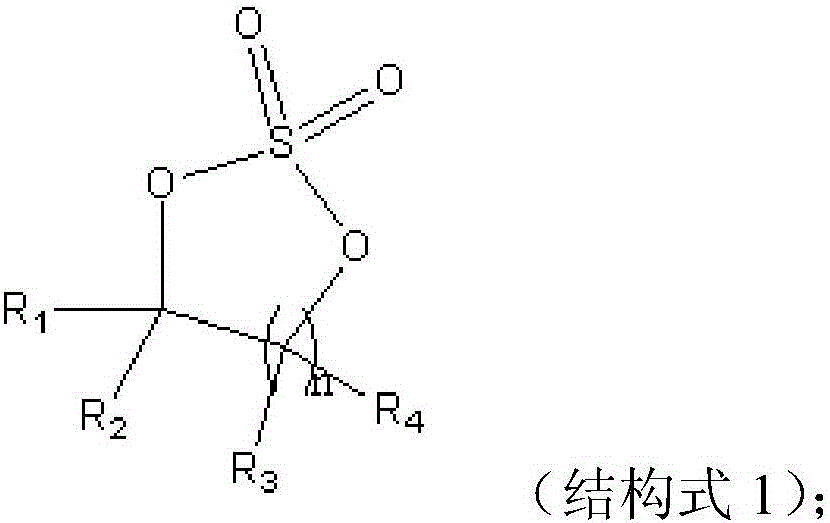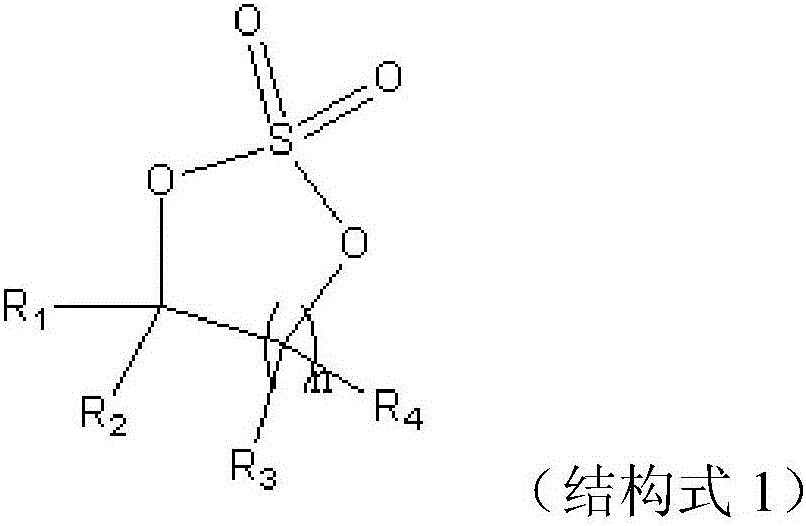Lithium ion battery employing non-aqueous electrolyte
A lithium-ion battery and non-aqueous electrolyte technology, which is applied in the field of lithium-ion batteries, can solve problems such as difficulty in taking into account low-temperature performance of the battery, failure to achieve cycle life, and large VC impedance, so as to improve cycle life, reduce impedance, and improve low-temperature performance Effect
- Summary
- Abstract
- Description
- Claims
- Application Information
AI Technical Summary
Problems solved by technology
Method used
Image
Examples
Embodiment 1
[0036] 1) Preparation of electrolyte
[0037] Mix ethylene carbonate (EC), diethyl carbonate (DEC) and ethyl methyl carbonate (EMC) according to the mass ratio of EC:DEC:EMC=1:1:1, and then add lithium hexafluorophosphate (LiPF 6 ) to a molar concentration of 1mol / L, then add 1% vinylene carbonate (VC), 0.5% vinyl sulfate (DTD), and 1% fluorobenzene as additives based on the total mass of the electrolyte.
[0038] 2) Preparation of positive plate
[0039] Mix the positive electrode active material LiFePO according to the mass ratio of 93:4:3 4 , conductive carbon black Super-P and binder polyvinylidene fluoride (PVDF), and then disperse them in N-methyl-2-pyrrolidone (NMP) to obtain positive electrode slurry. The slurry is uniformly coated on both sides of the aluminum foil, dried, calendered and vacuum-dried, and an aluminum lead-out wire is welded on by an ultrasonic welder to obtain a positive plate with a thickness of 120-150 μm.
[0040] 3) Preparation of negative plat...
Embodiment 2
[0057] As shown in Table 1, except that additives are replaced by 2% vinylene carbonate (VC), 1% vinyl sulfate (DTD), and 5% fluorobenzene in the preparation of the electrolyte, the other is the same as in Example 1. Similarly, the data of normal temperature cycle performance, high temperature storage performance and low temperature performance obtained from the test are shown in Table 3.
Embodiment 3
[0059] As shown in Table 1, except that additives are replaced by 3% vinylene carbonate (VC), 3% ethylene sulfate (DTD), and 10% fluorobenzene in the preparation of the electrolyte, other and embodiment 1 Similarly, the data of normal temperature cycle performance, high temperature storage performance and low temperature performance obtained from the test are shown in Table 3.
PUM
| Property | Measurement | Unit |
|---|---|---|
| thickness | aaaaa | aaaaa |
| thickness | aaaaa | aaaaa |
Abstract
Description
Claims
Application Information
 Login to View More
Login to View More - R&D
- Intellectual Property
- Life Sciences
- Materials
- Tech Scout
- Unparalleled Data Quality
- Higher Quality Content
- 60% Fewer Hallucinations
Browse by: Latest US Patents, China's latest patents, Technical Efficacy Thesaurus, Application Domain, Technology Topic, Popular Technical Reports.
© 2025 PatSnap. All rights reserved.Legal|Privacy policy|Modern Slavery Act Transparency Statement|Sitemap|About US| Contact US: help@patsnap.com



